An SIW Quasi-Pyramid Horn Antenna Based on Patch Coupling Feed for Automotive Radar Sensors
Abstract
:1. Introduction
2. Antenna Element Design and Analysis
2.1. SIW Quasi-Pyramid Horn Antenna Element
- Calculate the number Nasi of approximate spacing between adjacent metallized vias. bi ÷ 0.6Nasi. The purpose of dividing 0.6 is to ensure that the distance between adjacent metallized via holes is approximately 0.6 mm, thereby satisfying electromagnetic wave constraints. Nasi is generally rounded off to the nearest whole number.
- Determine the number N of metallized vias. NNasi + 1.
- Determine the spacing si between adjacent metallized vias. sibi ÷ N. For varying length bi, si is a variable value. However, the value of si is always maintained at approximately 0.6mm.
- Finally, based on the aforementioned design steps, the number N of metallized vias and the spacing si between adjacent metallized vias can be obtained.
2.2. Simulation Performance Analysis
3. Array Design
3.1. Patch Coupling Feed Structure Design
3.2. Design of Four-Port Inverting Power Divider
4. Experimental Results, Discussion, and Error Analysis
4.1. Experimental Results and Discussion
4.2. Error Analysis
5. Conclusions
Author Contributions
Funding
Data Availability Statement
Acknowledgments
Conflicts of Interest
References
- Beer, S.; Adamiuk, G.; Zwick, T. Novel antenna concept for compact millimeter-wave automotive radar sensors. IEEE Antennas Wirel. Propag. Lett. 2009, 8, 771–774. [Google Scholar] [CrossRef]
- Hasch, J.; Topak, E.; Schnabel, R.; Zwick, T.; Weigel, R.; Waldschmidt, C. Millimeter-wave technology for automotive radar sensors in the 77 GHz frequency band. IEEE Trans. Microw. Theory Tech. 2012, 60, 845–860. [Google Scholar] [CrossRef]
- Waldschmidt, C.; Hasch, J.; Menzel, W. Automotive radar—From first efforts to future systems. IEEE J. Microw. 2021, 1, 135–148. [Google Scholar] [CrossRef]
- Menzel, W.; Moebius, A. Antenna concepts for millimeter-wave automotive radar sensors. Proc. IEEE 2012, 100, 2372–2379. [Google Scholar] [CrossRef]
- Qiao, W.; Zhou, C.; Yin, W.; Lv, M.; Zhao, Z. A VHF Circularly Polarized Turnstile Antenna with Balun for Meteor Radar. Remote Sens. 2023, 15, 2058. [Google Scholar] [CrossRef]
- Li, L.; Zhu, R.; Li, H.; Zhou, J. Human posture recognition based on multi-channel SAR at 77 GHz. In Proceedings of the 2019 IEEE 2nd International Conference on Automation, Electronics and Electrical Engineering (AUTEEE), Shenyang, China, 22–24 November 2019; IEEE: Piscataway, NJ, USA, 2019; pp. 559–563. [Google Scholar]
- Mei, Z.; Wu, Q.; Hu, Z.; Tao, J. A fast non-contact vital signs detection method based on regional hidden Markov Model in a 77GHz LFMCW radar system. In Proceedings of the ICASSP 2020–2020 IEEE International Conference on Acoustics, Speech and Signal Processing (ICASSP), Barcelona, Spain, 4–8 May 2020; IEEE: Piscataway, NJ, USA, 2020; pp. 1145–1149. [Google Scholar]
- Zhao, P.; Li, N.; Shan, Y.; Bao, J. Design and analysis of microstrip transceiver array antennas with the function to suppress beam deflection for 77 GHz automotive radar. AEU-Int. J. Electron. Commun. 2023, 162, 154587. [Google Scholar] [CrossRef]
- Ku, B.H.; Schmalenberg, P.; Inac, O.; Gurbuz, O.D.; Lee, J.S.; Shiozaki, K.; Rebeiz, G.M. A 77–81-GHz 16-Element Phased-Array Receiver With ±50∘ Beam Scanning for Advanced Automotive Radars. IEEE Trans. Microw. Theory Tech. 2014, 62, 2823–2832. [Google Scholar] [CrossRef]
- Yi, H.; Wang, Z.; Xia, D.; Liu, H.; Li, L. Periodic Asymmetric Trapezoidal Perturbation Microstrip Antenna for Millimeter-Wave Automotive Radar Sensors. IEEE Trans. Antennas Propag. 2022, 71, 1369–1377. [Google Scholar] [CrossRef]
- Zhou, R.; Dong, H.; Hou, D.; Chen, J. Design and Implementation of a Compact 77-GHz FMCW Radar Based on Single-Chip Transceiver with Comb-Line Antenna. In Proceedings of the 2020 IEEE MTT-S International Wireless Symposium (IWS), Shanghai, China, 20–23 September 2020; IEEE: Piscataway, NJ, USA, 2020; pp. 1–3. [Google Scholar]
- Apriono, C.; Mahatmanto, B.P.A.; Juwono, F.H. Rectangular Microstrip Array Feed Antenna for C-Band Satellite Communications: Preliminary Results. Remote Sens. 2023, 15, 1126. [Google Scholar] [CrossRef]
- Tu, H.; Pan, X.; Chen, L.; Meng, X.; Hu, R.; Liu, Y.; Zhang, J.; Zhao, M.; Liu, J.; Huang, W.; et al. Real-Time Millimeter-Wave Imaging for Moving Targets Realized in a Sparse Array Based on InP-HBT MMICs. IEEE Trans. Microw. Theory Tech. 2022, 70, 4478–4490. [Google Scholar] [CrossRef]
- Grajal, J.; Badolato, A.; Rubio-Cidre, G.; Ubeda-Medina, L.; Mencia-Oliva, B.; Garcia-Pino, A.; Gonzalez-Valdes, B.; Rubinos, O. 3-D high-resolution imaging radar at 300 GHz with enhanced FoV. IEEE Trans. Microw. Theory Tech. 2015, 63, 1097–1107. [Google Scholar] [CrossRef]
- Yang, Y.; Wang, X.S. Enhanced Radar Detection in the Presence of Specular Reflection Using a Single Transmitting Antenna and Three Receiving Antennas. Remote Sens. 2023, 15, 3204. [Google Scholar] [CrossRef]
- Kim, E.; Kim, I.; Kim, W. Non-Uniform MIMO Array Design for Radar Systems Using Multi-Channel Transceivers. Remote Sens. 2022, 15, 78. [Google Scholar] [CrossRef]
- Mohamed, I.; Sebak, A. Broadband transition of substrate-integrated waveguide-to-air-filled rectangular waveguide. IEEE Microw. Wirel. Compon. Lett. 2018, 28, 966–968. [Google Scholar] [CrossRef]
- Luo, N.; Yu, X.; Mishra, G.; Sharma, S.K. A millimeter-wave (V-band) dual-circular-polarized horn antenna based on an inbuilt monogroove polarizer. IEEE Antennas Wirel. Propag. Lett. 2020, 19, 1933–1937. [Google Scholar] [CrossRef]
- Xu, F.; Wu, K. Guided-wave and leakage characteristics of substrate integrated waveguide. IEEE Trans. Microw. Theory Tech. 2005, 53, 66–73. [Google Scholar]
- Deslandes, D.; Wu, K. Accurate modeling, wave mechanisms, and design considerations of a substrate integrated waveguide. IEEE Trans. Microw. Theory Tech. 2006, 54, 2516–2526. [Google Scholar] [CrossRef]
- Balanis, C.A. Antenna Theory: Analysis and Design; John Wiley & Sons: Hoboken, NJ, USA, 2016. [Google Scholar]
- Gu, Z.; Wu, X.H.; Zhang, Q. Substrate-integrated E-plane waveguide horn antenna and antenna array. IEEE Trans. Antennas Propag. 2018, 66, 2382–2391. [Google Scholar] [CrossRef]
- Choudhury, S.; Mohan, A.; Mishra, P.K.; Guha, D. Wideband pyramidal ridged horn design by SIW technology. IEEE Antennas Wirel. Propag. Lett. 2019, 18, 1517–1521. [Google Scholar] [CrossRef]
- Gong, L.; Fu, Y.; Chan, K.Y.; Nanzer, J.A.; Ramer, R. An SIW horn antenna fed by a coupled mode emulating pyramidal horn antennas. IEEE Trans. Antennas Propag. 2019, 68, 33–42. [Google Scholar] [CrossRef]
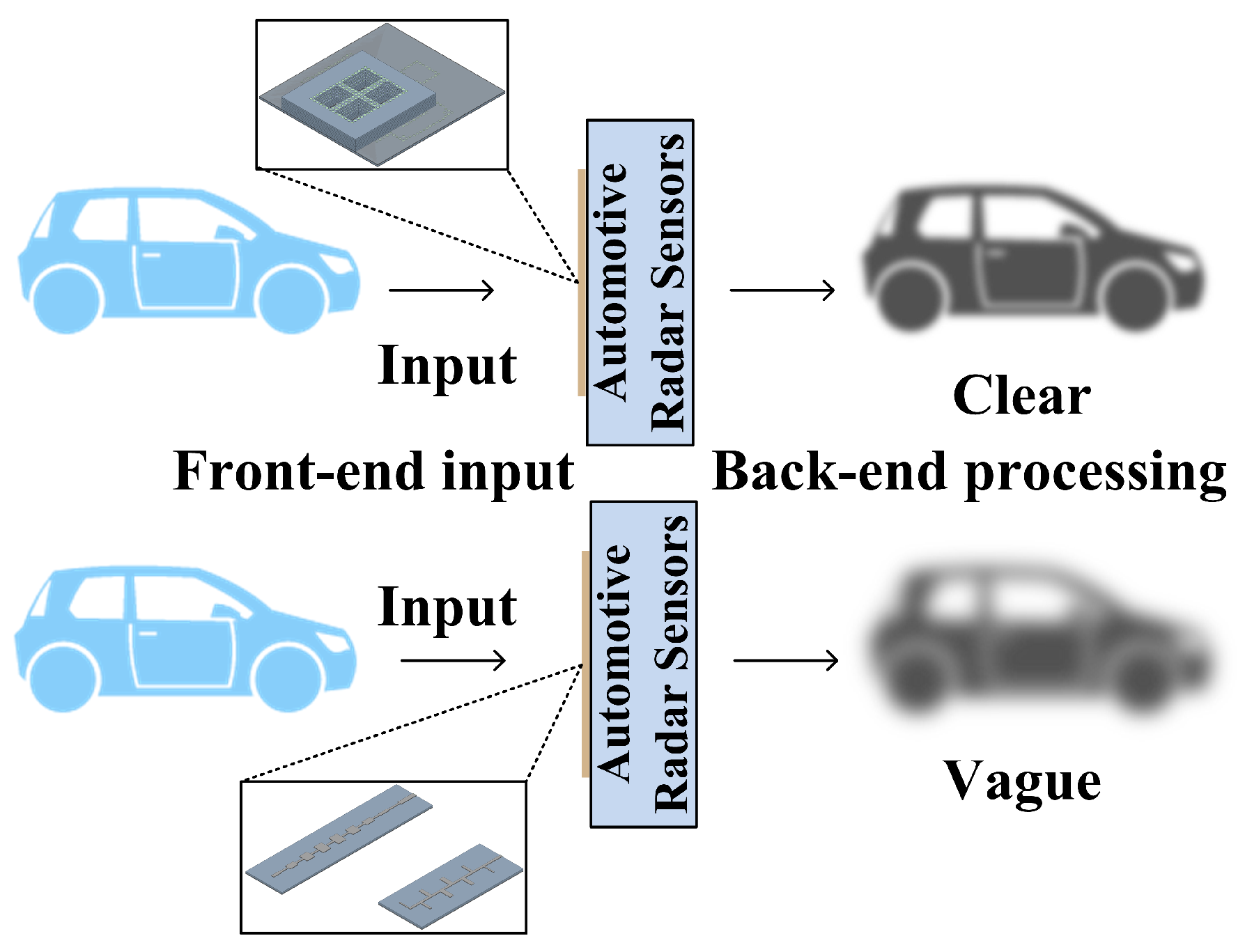
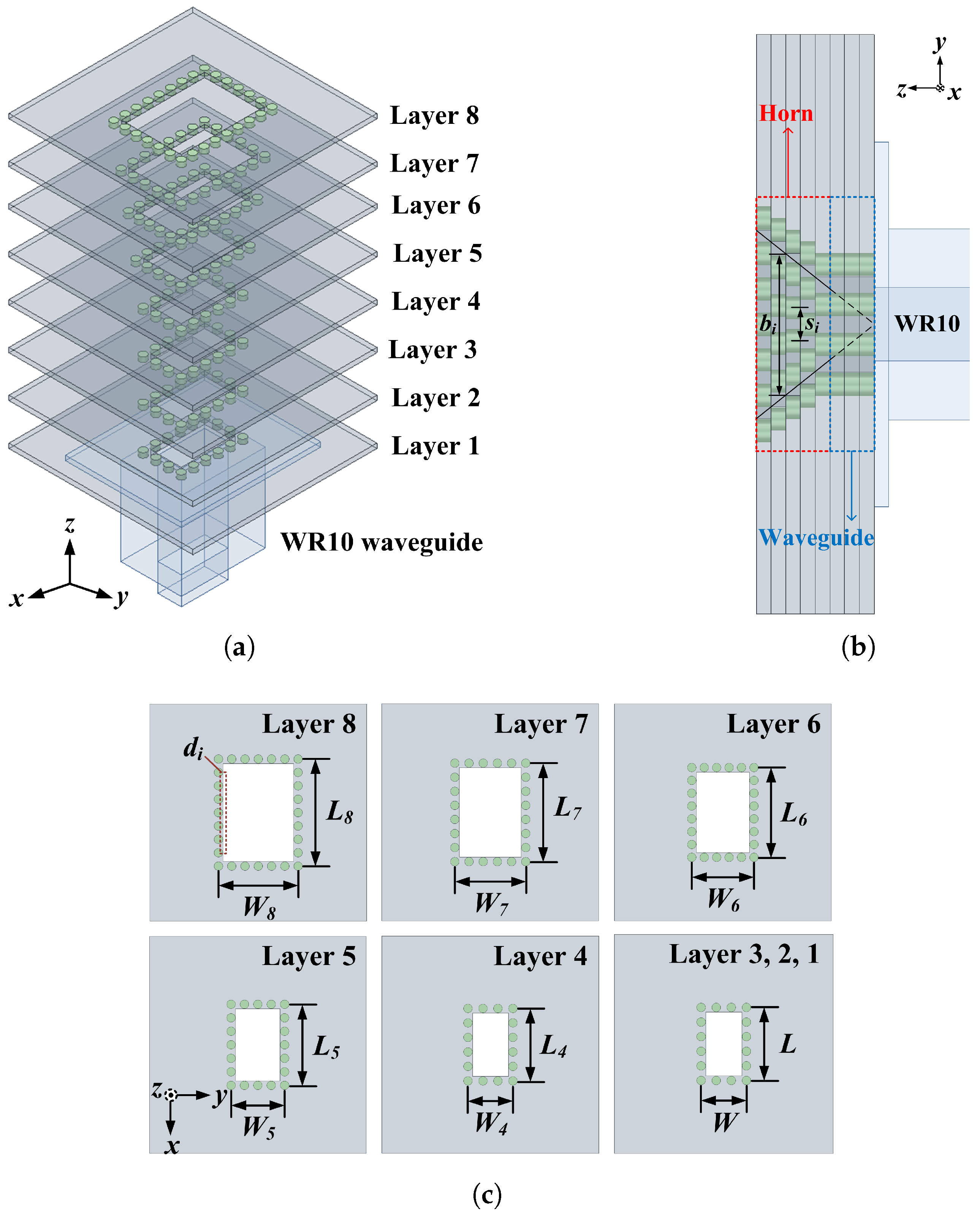
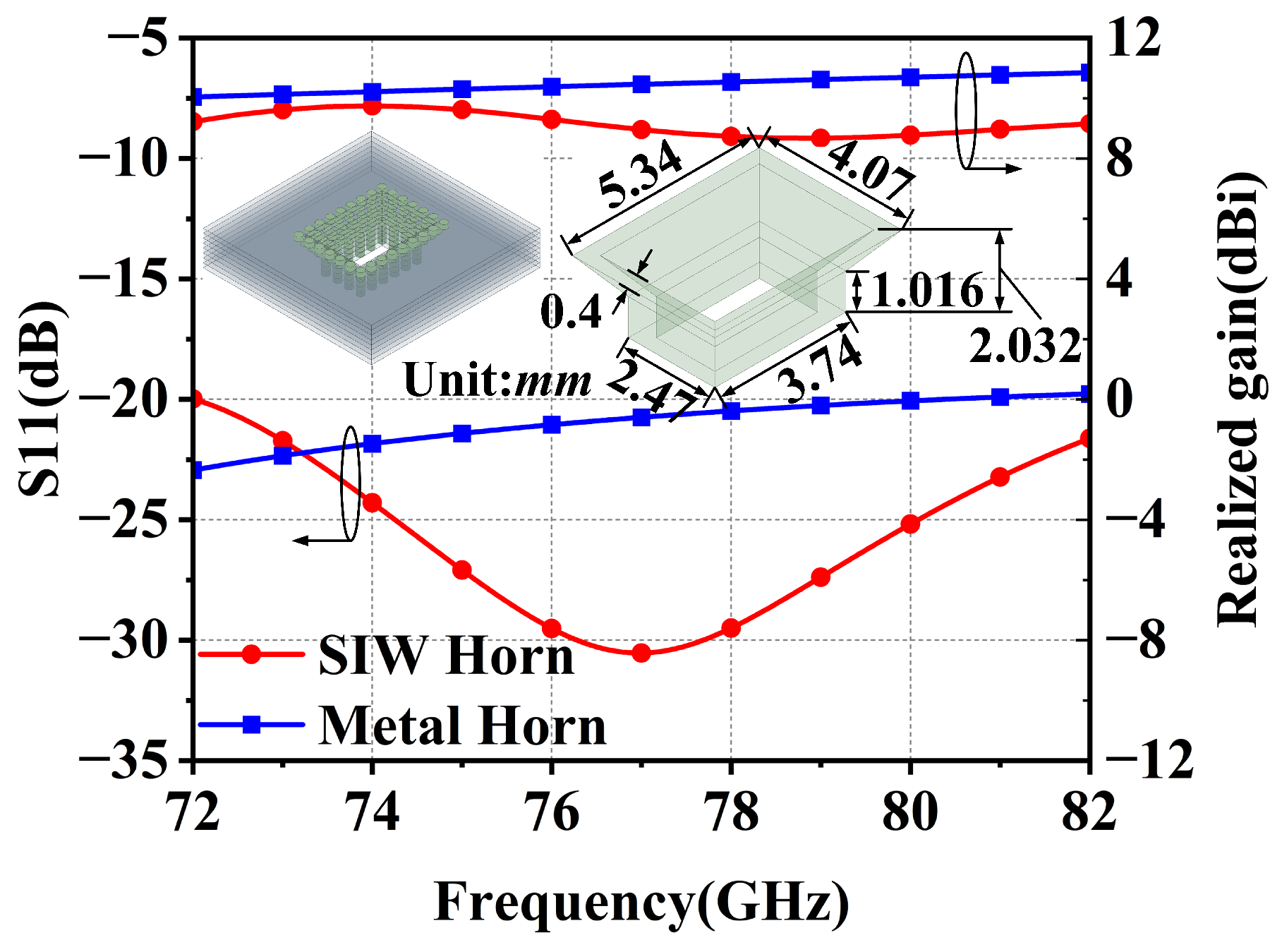


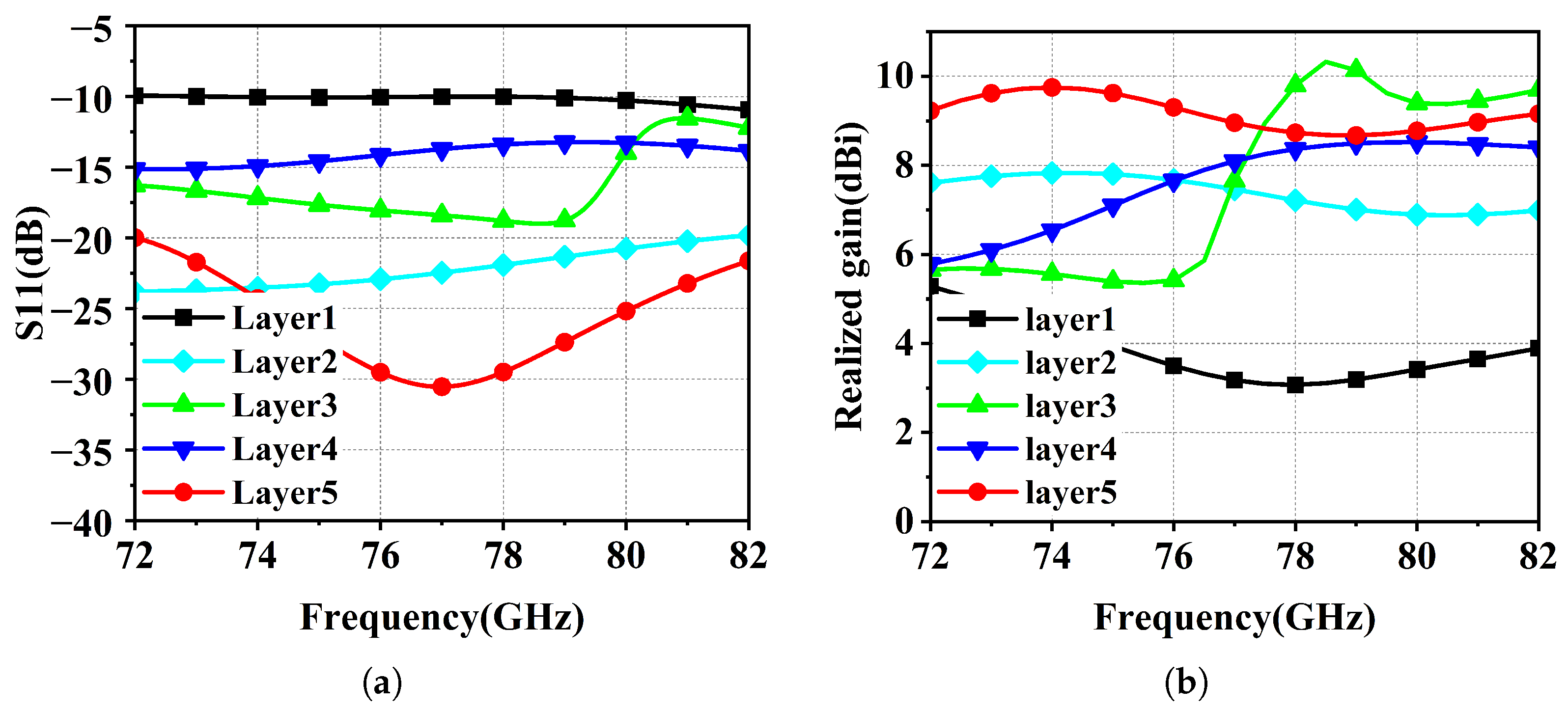
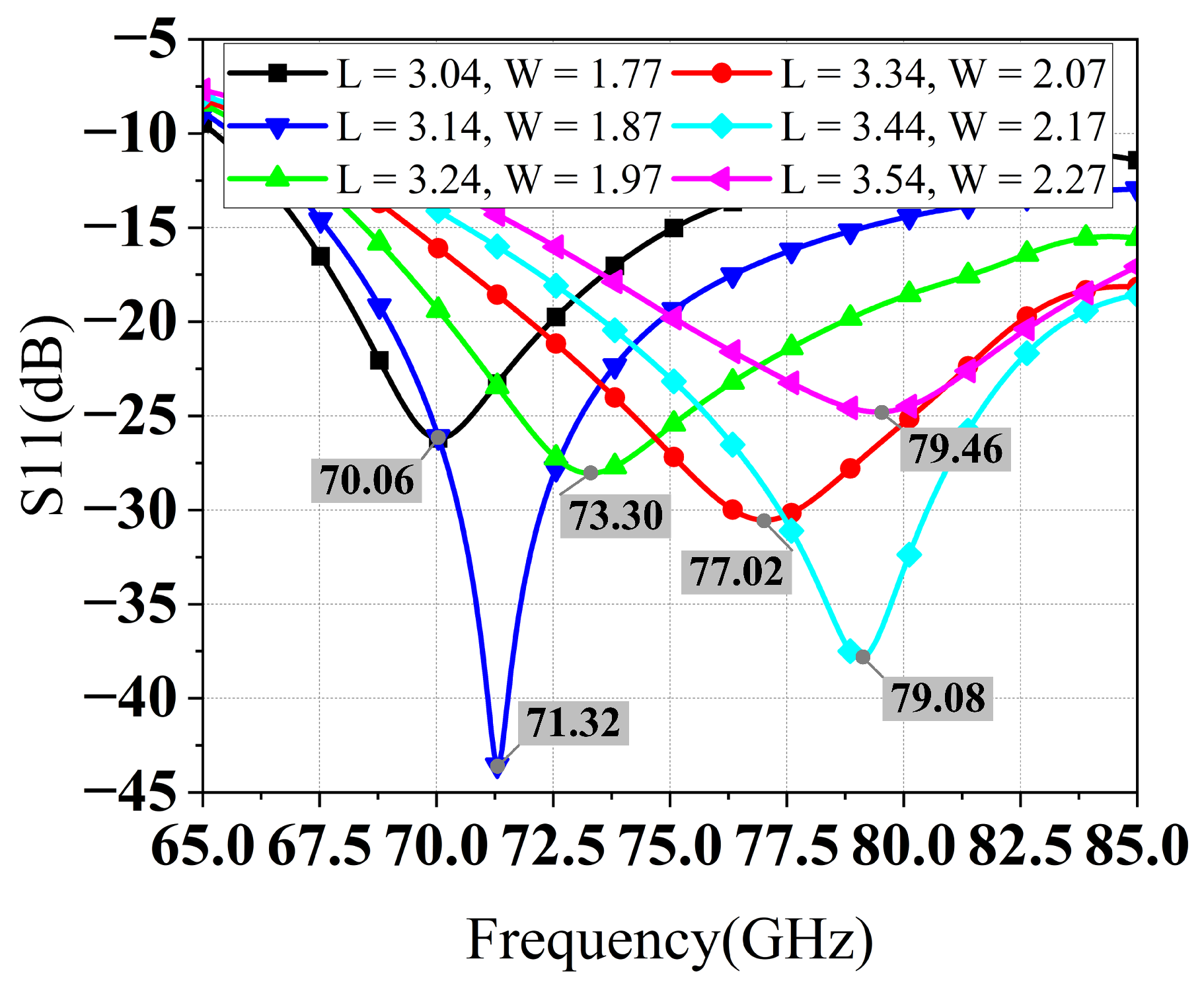

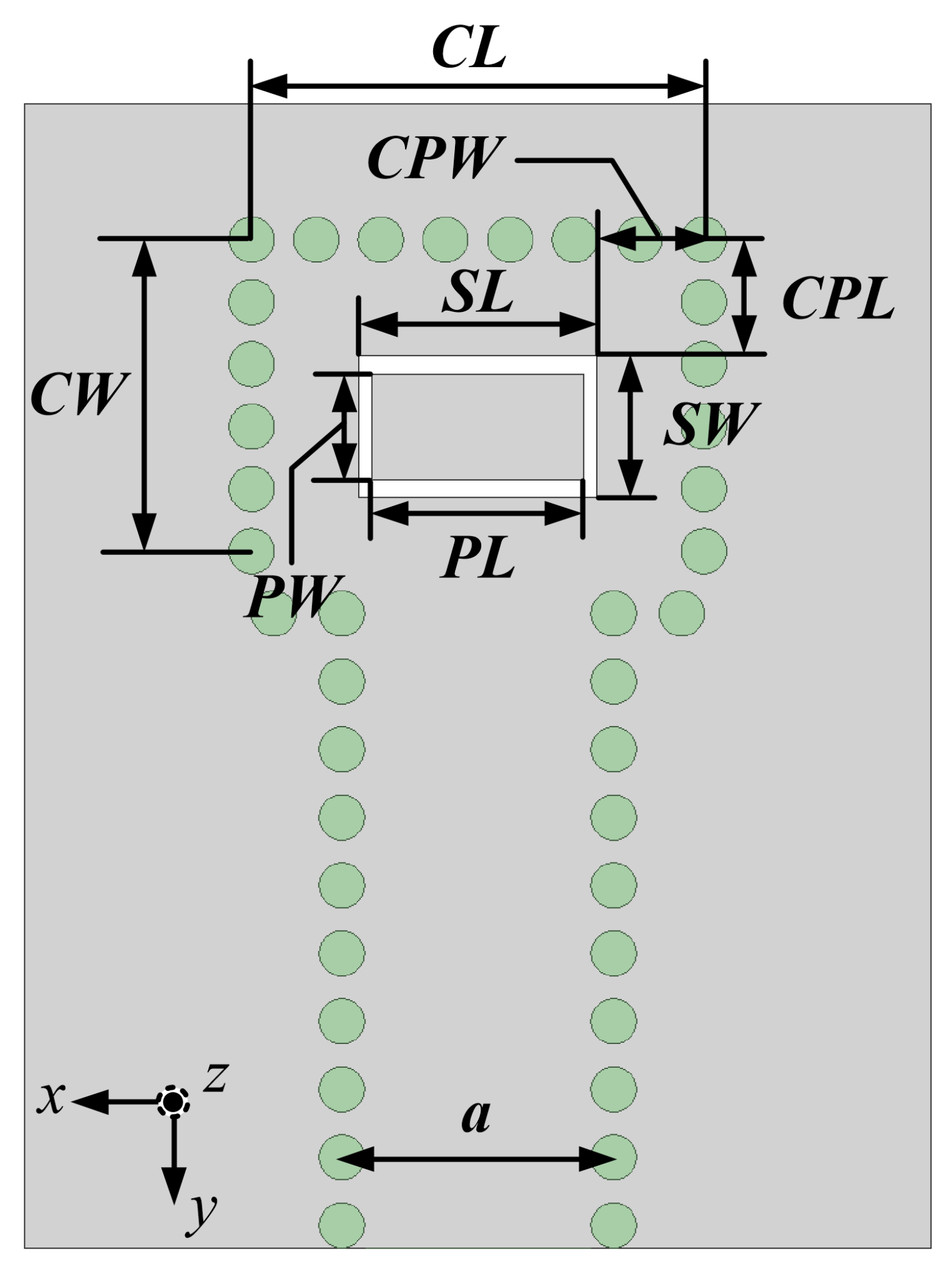

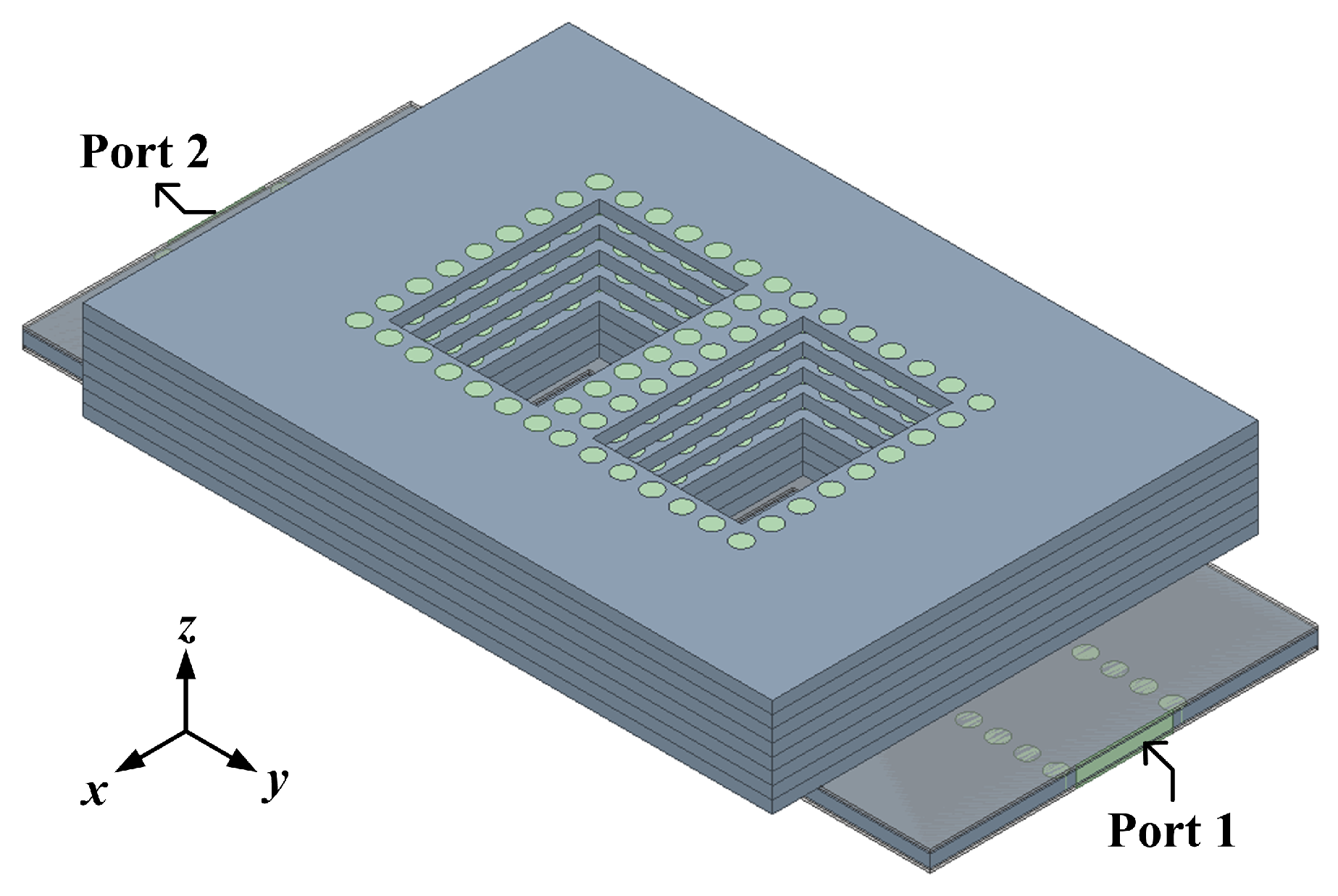
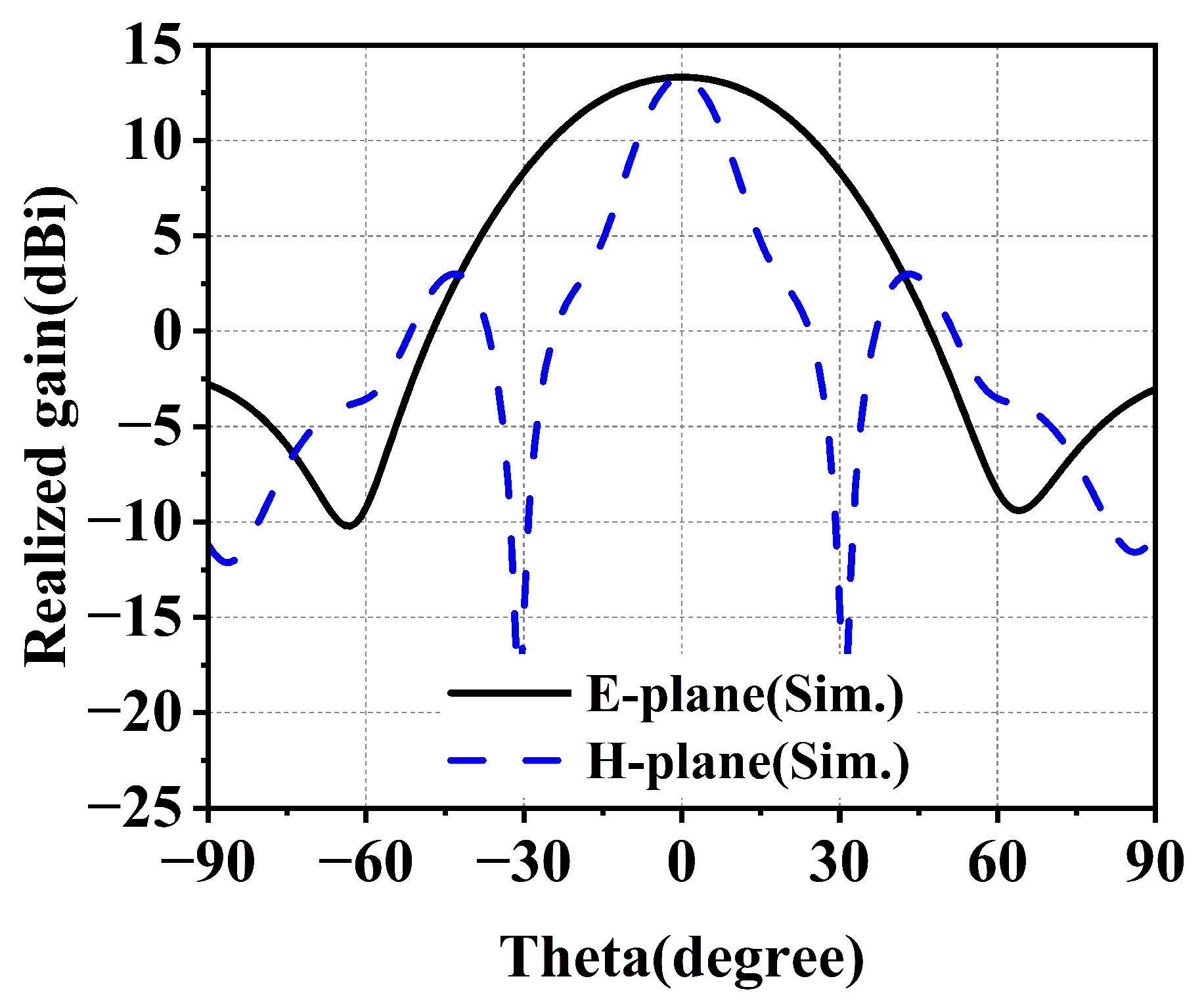
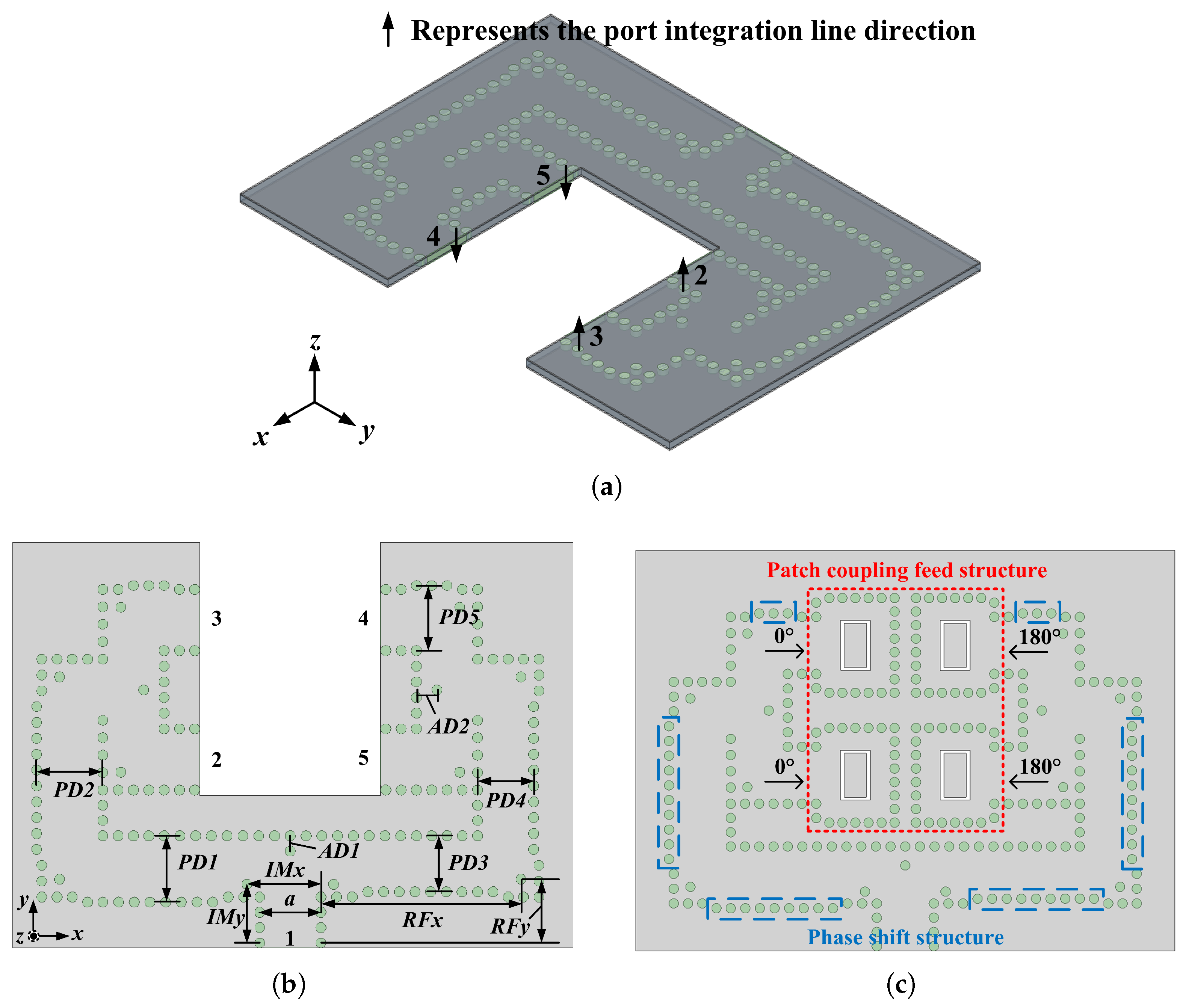
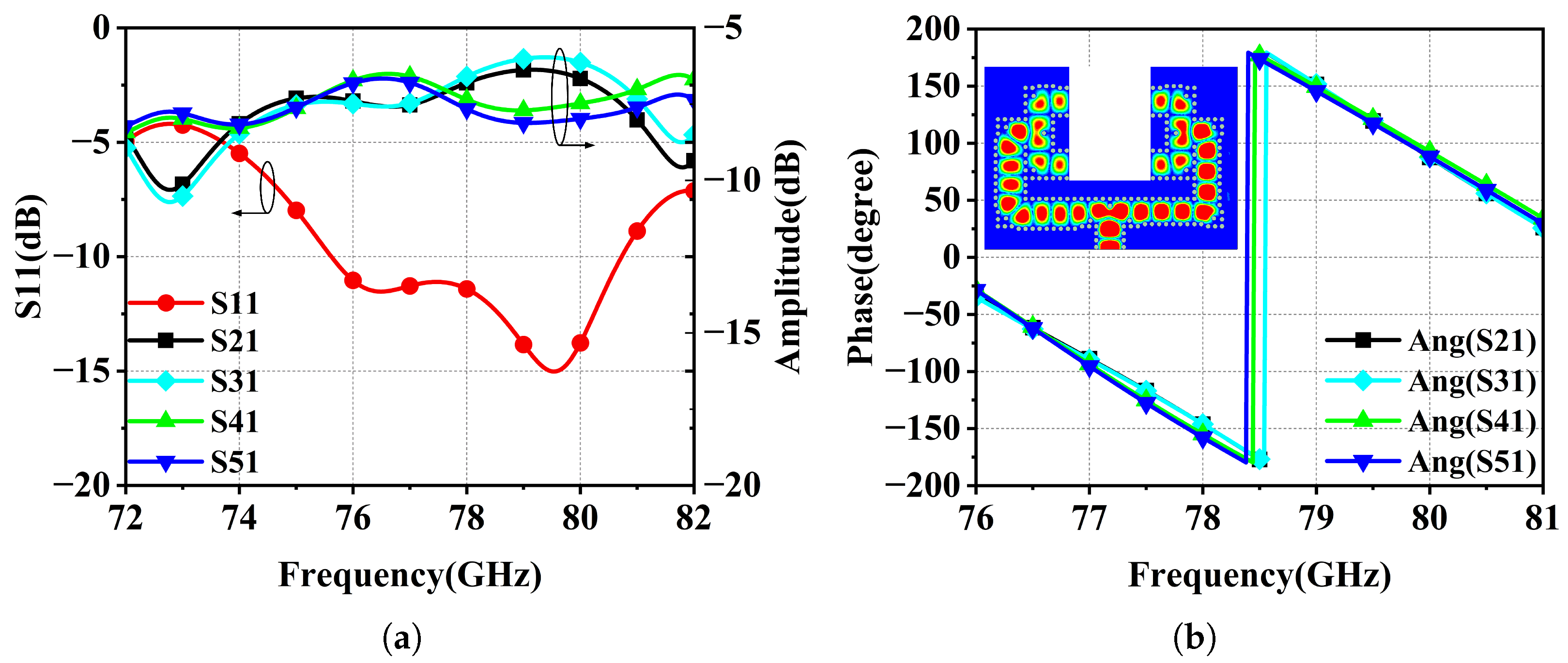
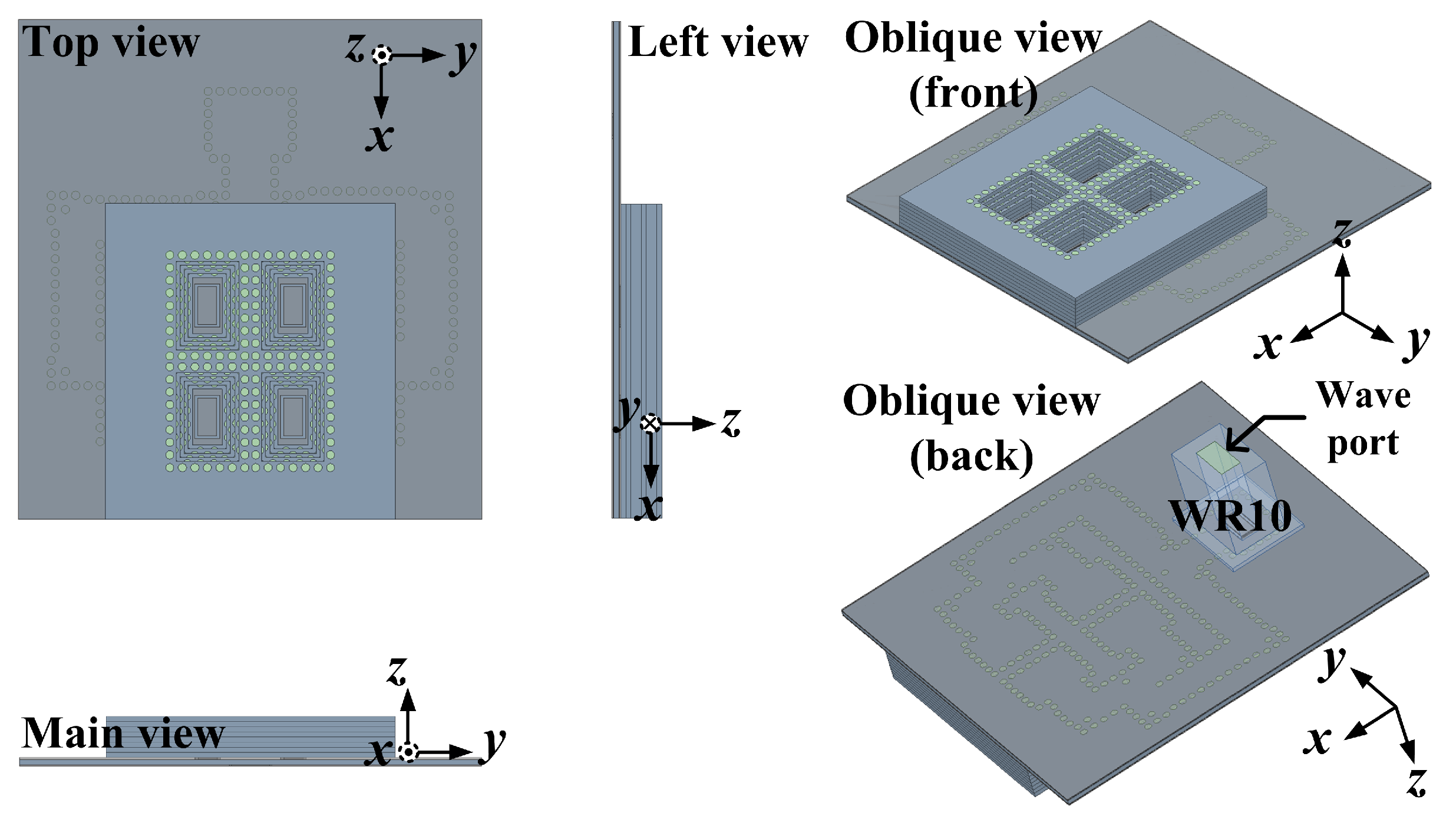
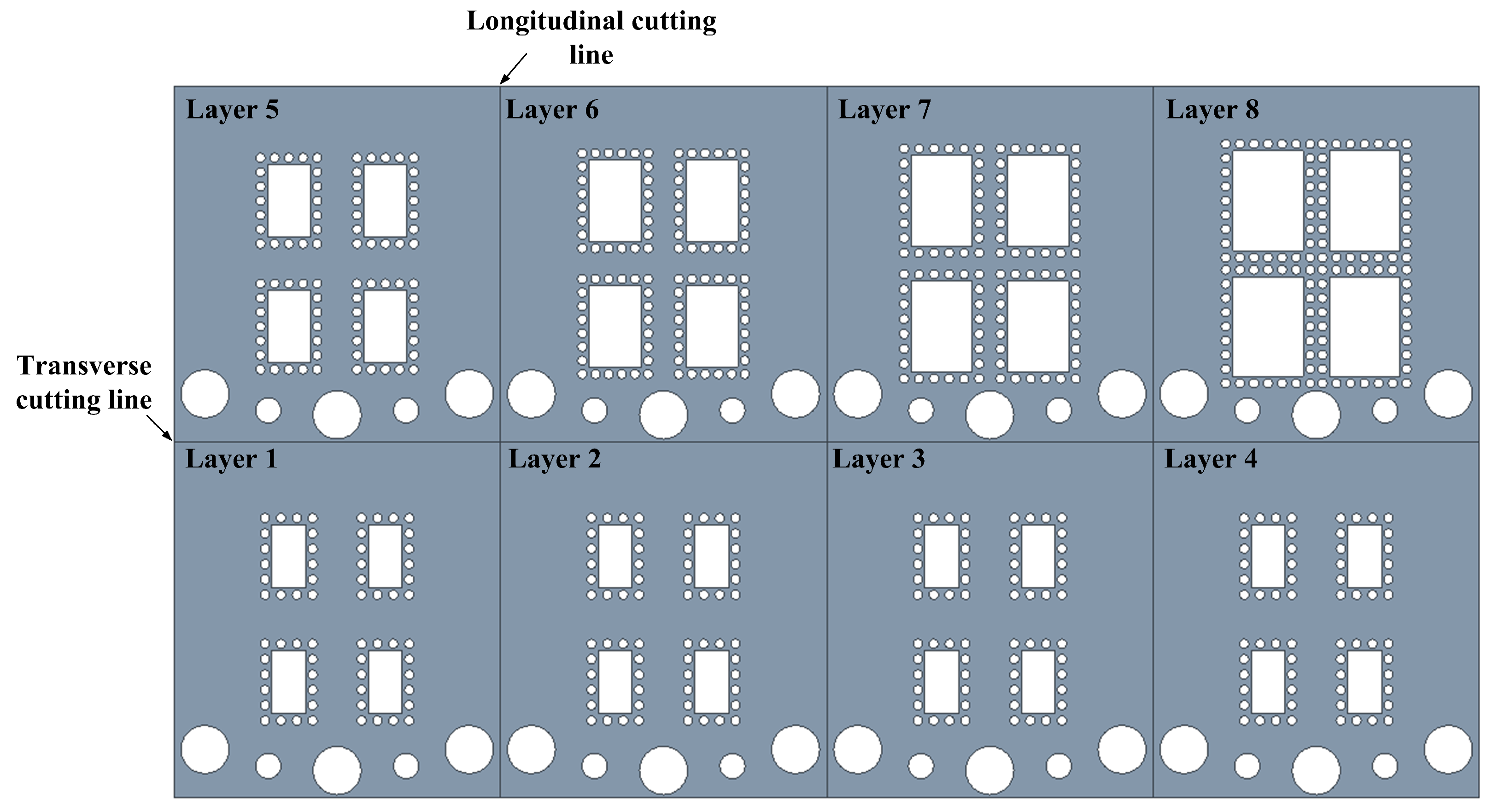
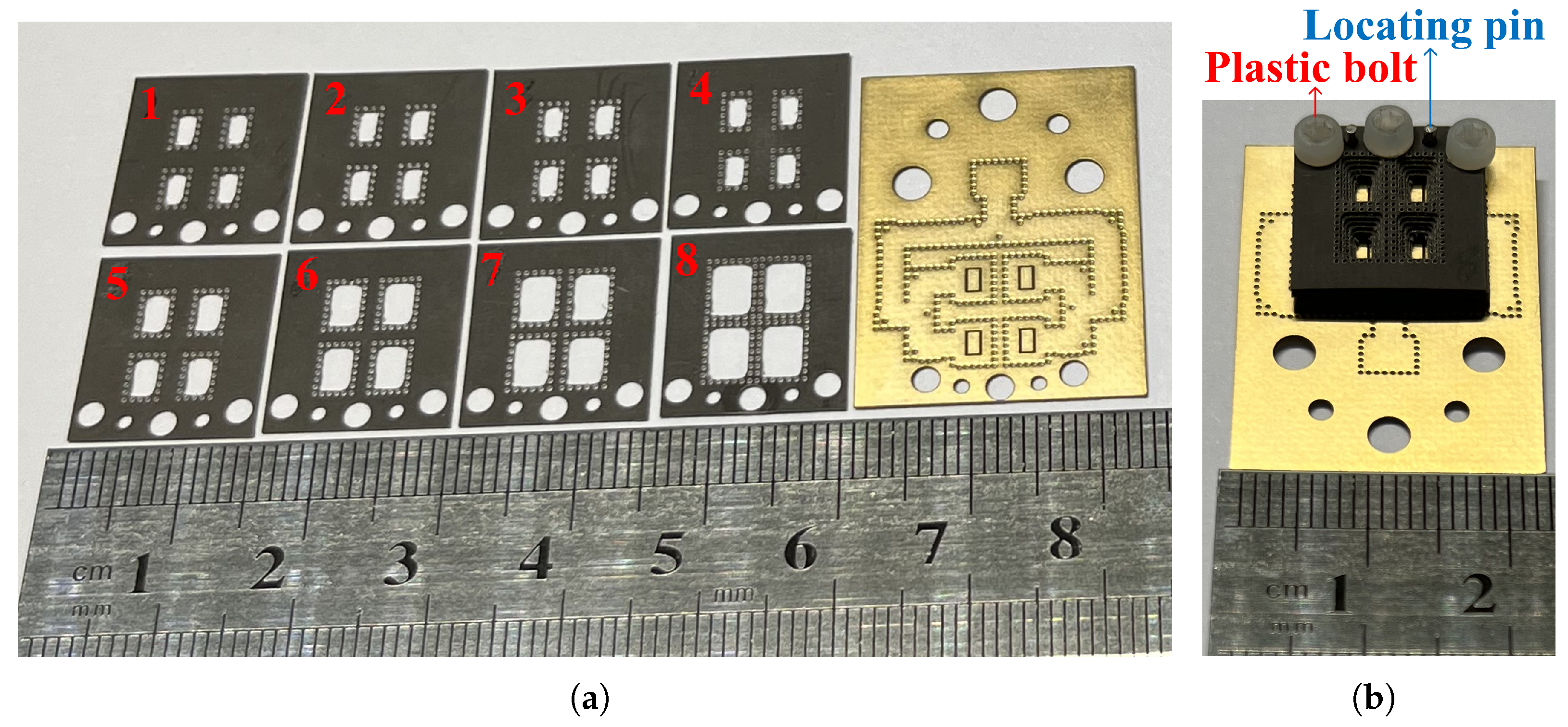
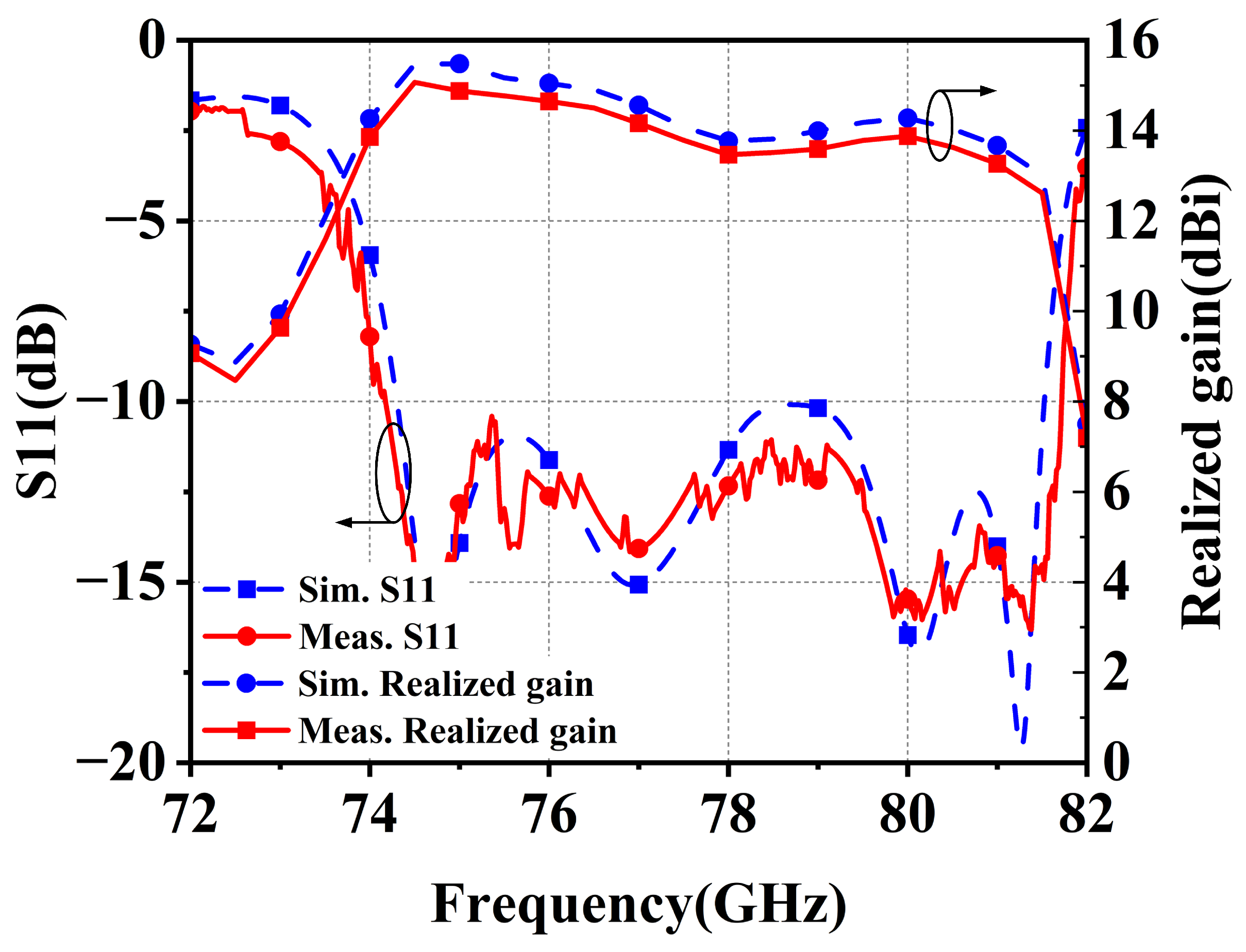
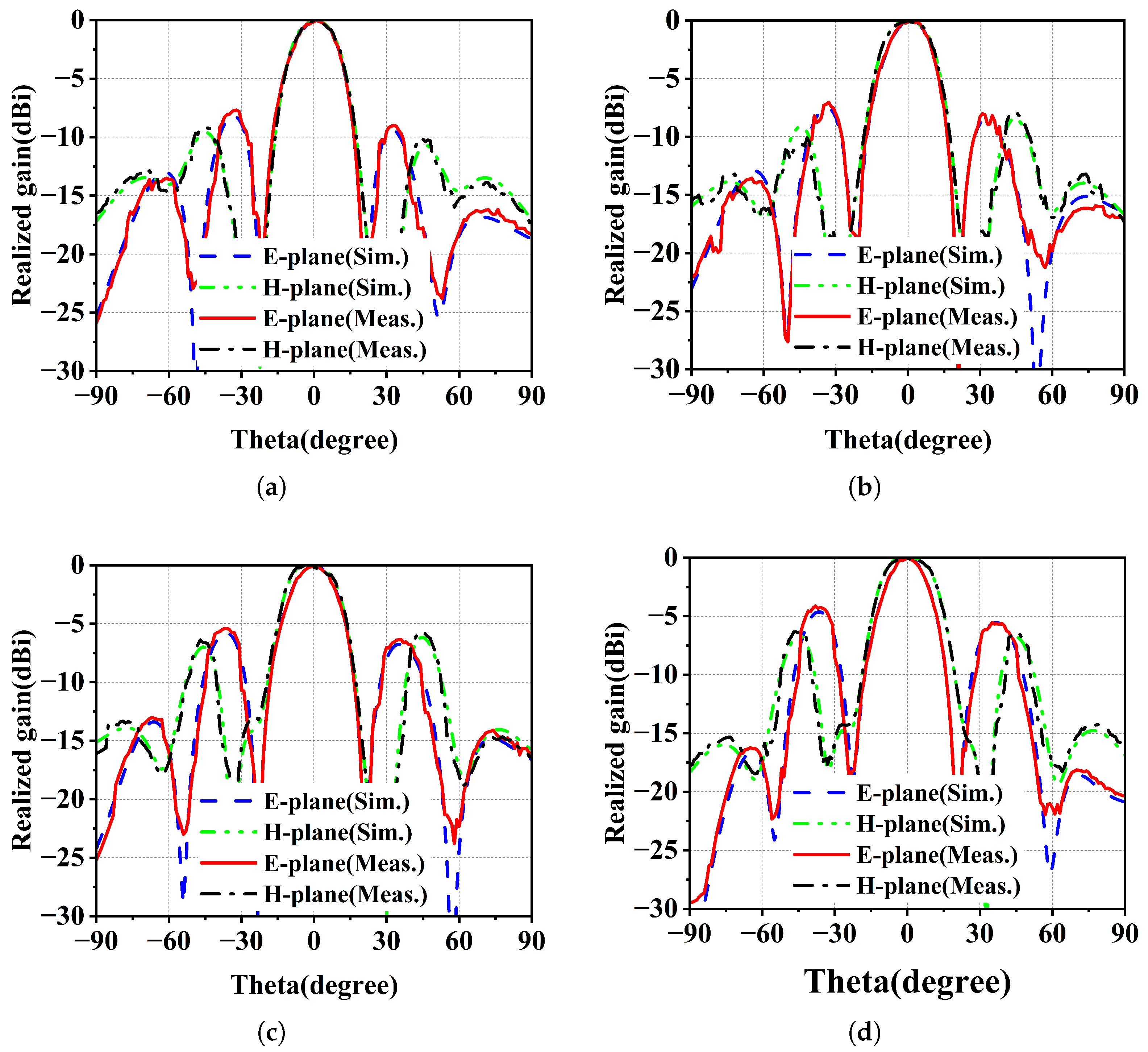
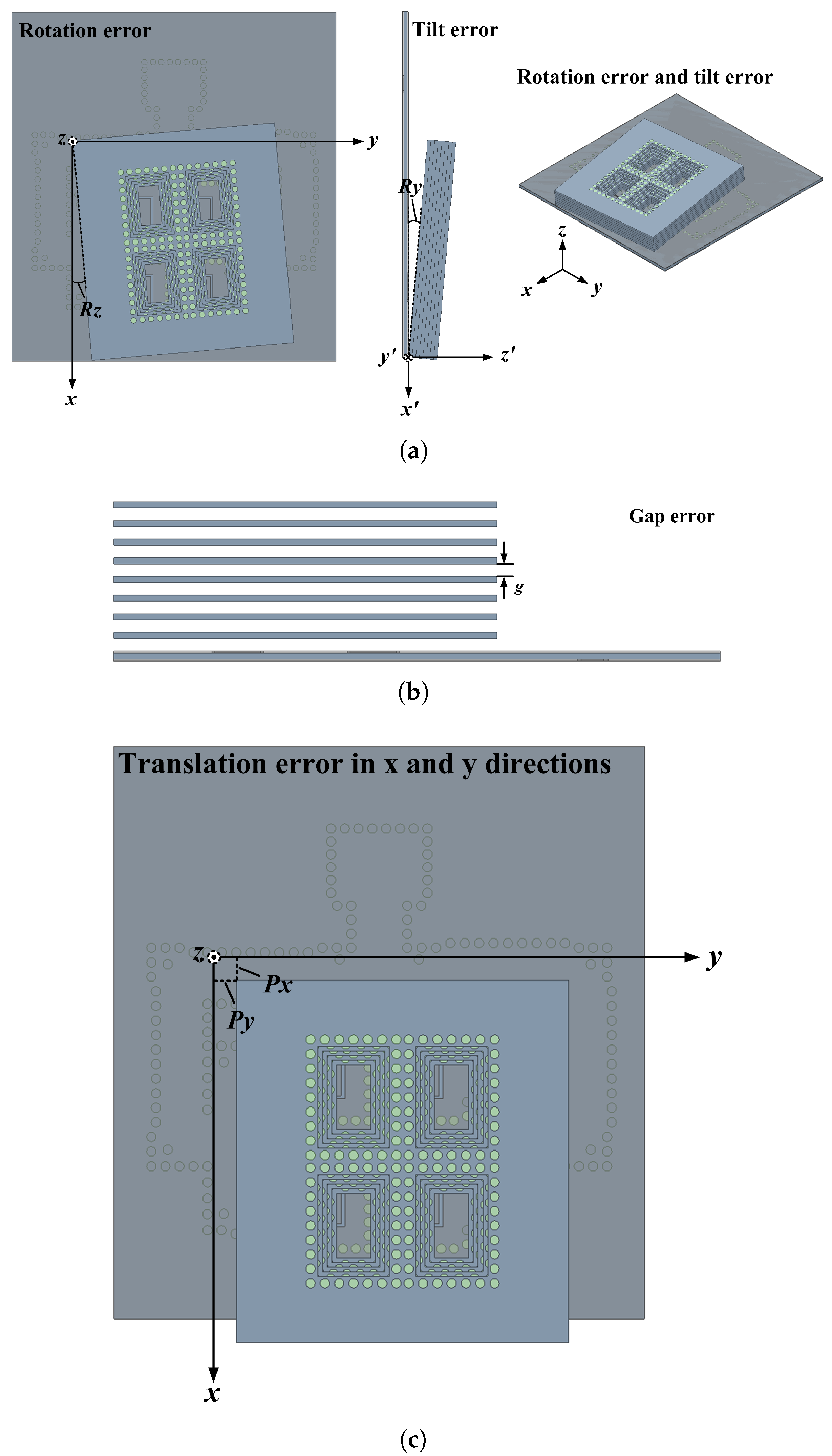
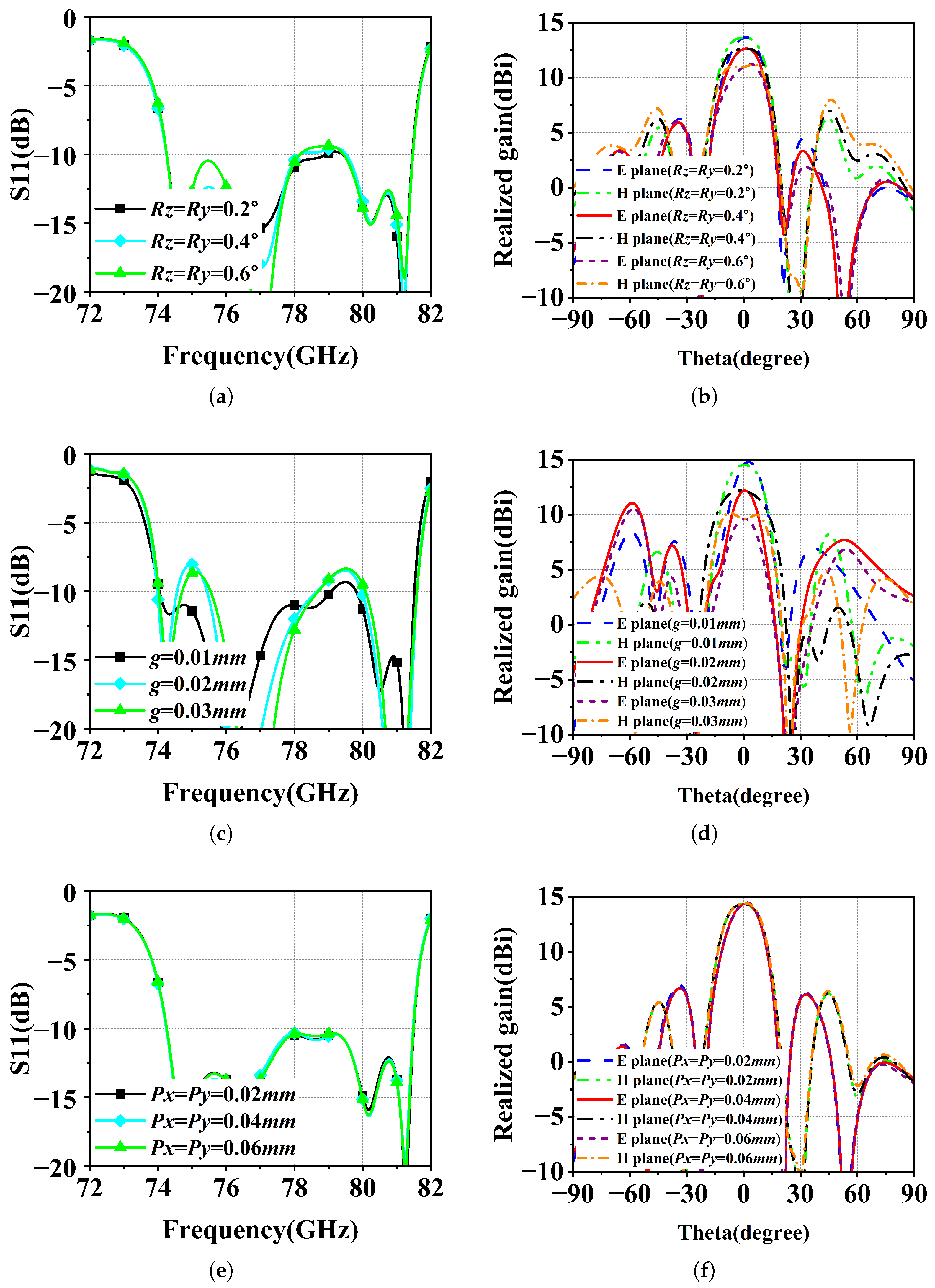
| Parameters | L8 (b8) | L7 (b7) | L6 (b6) | L5 (b5) | L4 (b4) | L |
|---|---|---|---|---|---|---|
| Value (mm) | 4.94 | 4.54 | 4.14 | 3.74 | 3.34 | 3.34 |
| Parameters | W8 (a8) | W7 (a7) | W6 (a6) | W5 (a5) | W4 (a4) | W |
| Value (mm) | 3.67 | 3.27 | 2.87 | 2.47 | 2.07 | 2.07 |
| Parameters | s8 | s7 | s6 | s5 | s4 | s |
| Value (mm) | 0.618 | 0.649 | 0.591 | 0.623 | 0.668 | 0.668 |
| Parameters | CL | CW | SL | SW | PL | PW | a | CPL | CPW |
|---|---|---|---|---|---|---|---|---|---|
| Value (mm) | 3.99 | 2.75 | 2.1 | 1.25 | 1.86 | 0.94 | 2.4 | 1.025 | 0.945 |
| Parameters | a | RFx | RFy | IMx | IMy | AD1 |
|---|---|---|---|---|---|---|
| Value (mm) | 2.4 | 7.85 | 2.5 | 2.9 | 2.3 | 0.6 |
| Parameters | AD2 | PD1 | PD2 | PD3 | PD4 | PD5 |
| Value (mm) | 0.8 | 2.6 | 2.6 | 2.2 | 2.2 | 2.55 |
| Ref. | Fre. (GHz) | Structure | Relative | Apeture | G. or R.G. * | Radiation |
|---|---|---|---|---|---|---|
| Type | Bandwidth | Size () | (dBi) | Efficiency | ||
| [22] | 18 | SIW | 19.89% | 2.67×1.9 × 0.31 | 11.4 | 85% |
| [23] | 40 | SIW | 69.7% | 4.5 ′ × 3.9 × 2.5 | 14.8 | 85% |
| [24] | 35 | SIW | 0.81% ′ | 12.4 ′ × 2.71 × 2.06 | 13.1 * | 93.5% |
| [18] | 57 | Metal | 10.53% | 7.6 × 1.6 × 1.6 | 12 * | 76% |
| This work | 77 | SIW | 9.27% | 6.3 × 5.8 × 0.59 | 14.56 * | 80.7% |
Disclaimer/Publisher’s Note: The statements, opinions and data contained in all publications are solely those of the individual author(s) and contributor(s) and not of MDPI and/or the editor(s). MDPI and/or the editor(s) disclaim responsibility for any injury to people or property resulting from any ideas, methods, instructions or products referred to in the content. |
© 2024 by the authors. Licensee MDPI, Basel, Switzerland. This article is an open access article distributed under the terms and conditions of the Creative Commons Attribution (CC BY) license (https://creativecommons.org/licenses/by/4.0/).
Share and Cite
Zhao, P.; Li, N.; Zhang, Y.; Hu, N. An SIW Quasi-Pyramid Horn Antenna Based on Patch Coupling Feed for Automotive Radar Sensors. Remote Sens. 2024, 16, 692. https://doi.org/10.3390/rs16040692
Zhao P, Li N, Zhang Y, Hu N. An SIW Quasi-Pyramid Horn Antenna Based on Patch Coupling Feed for Automotive Radar Sensors. Remote Sensing. 2024; 16(4):692. https://doi.org/10.3390/rs16040692
Chicago/Turabian StyleZhao, Pengchao, Na Li, Yiqun Zhang, and Naigang Hu. 2024. "An SIW Quasi-Pyramid Horn Antenna Based on Patch Coupling Feed for Automotive Radar Sensors" Remote Sensing 16, no. 4: 692. https://doi.org/10.3390/rs16040692





